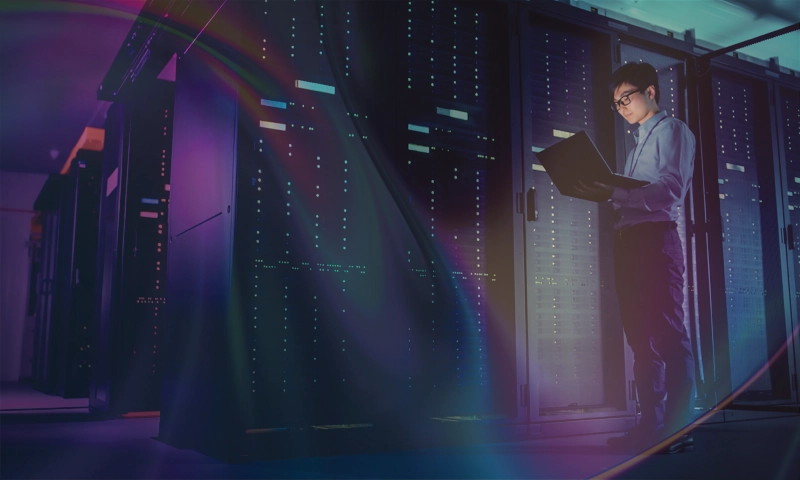The Lowdown on x86 Servers
We’ve all heard the term “server” at some point in our life, whether it’s your IT hardware manager yelling that you “need more servers ASAP!’ or a hacker in a movie explaining that he “just hacked into their servers” in a deep, ominous voice. But what exactly are servers, what do they do, and why do nefarious hackers with seemingly eerie voices try so hard to find their way into them?
Funny enough, the term “server” itself explains exactly what they do – they serve content to a user, in one way or another, similar to the way you request your food from a server at a restaurant, and they bring it to you. When you access LinkedIn to add a new connection, that webpage is being hosted by a server. When you access your company’s internal proprietary software tool, that is being hosted by a server. When you go to download an Excel spreadsheet on your company’s internal file share service, that service is being hosted by—you guessed it—a server.
Now that we know what a server does, it’s no wonder hackers are always trying to sneak their way into them. If you manage to gain access to a company’s server, you have free rein to manipulate all the sensitive data being stored on them.
Servers Are Really Just Fancy Computers
Given that servers are responsible for housing and hosting a myriad of critical applications to keep business flowing smoothly, it’s understandable to feel intimidated when working with them. However, when it comes to the base components of a server, they really aren’t any different from what’s inside your personal computer sitting on your desk at home. You have the same CPU(s), memory, drives, storage controller, IO ports, and power supplies. In fact, if you really wanted to, you could technically set up your home computer to act as a “server” of sorts. Although, the components within enterprise-grade servers commonly found in data centers are typically built to withstand the elevated and continuous workload required in the enterprise environment, an experience that your home PC doesn’t undergo.
Virtualizing Workloads in the Datacenter
Great, now we understand what a server is and why it’s such a crucial piece of any business’s infrastructure. But how exactly do they do what they do?
While you certainly can run your workloads directly on the server hardware itself, as you would on your home PC by installing your preferred operating system, the more common approach in the enterprise world is to use what’s known as virtualization. Sounds fancy, right? Well, it kind of is.
When you install an operating system directly onto the bare metal hardware, you can only boot to and interact with that single operating system, and most importantly, this single operating system interacts with all the underlying server components. With virtualization, instead of installing an operating system onto the bare metal, you first install what’s called a hypervisor onto the server. From the hypervisor, you can allocate specified portions of the underlying hardware to one or more operating systems, called virtual machines (VMs). This means that with virtualization, you can essentially run multiple “computers” (VMs) on a single piece of hardware.
Let’s consider the following example: Say I have a server with two 8-core CPUs and 64GB of memory. If I installed an operating system such as Windows Server directly onto this server, it would access all of those resources, and it would be my only operating system on the server. Now imagine I had multiple workloads I wanted to run on this single server, all requiring different amounts of resources and operating systems. If I instead installed a hypervisor, I could run the following virtual machines:
- A Linux-based CentOS machine hosting an internal application using two cores and 12GB of memory
- A Windows Server machine hosting Active Directory, acting as my domain controller, using four cores and 16GB of memory
- A pfSense machine as a firewall using eight cores and 24GB of memory
- A second Linux machine hosting a web application using the remaining two cores and 12GB of memory
As you can see in the example above, when we virtualize workloads, we’re truly able to get the most out of our server hardware. While there are some unique use cases where running a workload directly on the bare metal of the server makes sense, the majority of enterprise workloads take advantage of the virtualization concepts explained above. Some important benefits gained from workload virtualization include ease of disaster recovery (DR) through replication of live VMs to a DR site via snapshots and backups, and ease of scaling out by simply spawning more VMs as business workloads increase.
Wrapping It All Up
We have now explored exactly why servers are so critical in supporting businesses of all sizes across all industries. In the enterprise computing world, x86 servers function as the backbone that keep these businesses running every single day. Here at Curvature, we specialize in providing both individual parts and complete server builds from many of the industry’s leading OEMs, including Cisco, HPE, and Dell. When paired with our parent company, Park Place Technologies, which excels in providing support for this hardware, we serve as an excellent resource, whether you’re looking to add new nodes to your cluster or simply expand the capacity of your existing hardware.
To learn more, contact our experts today.


